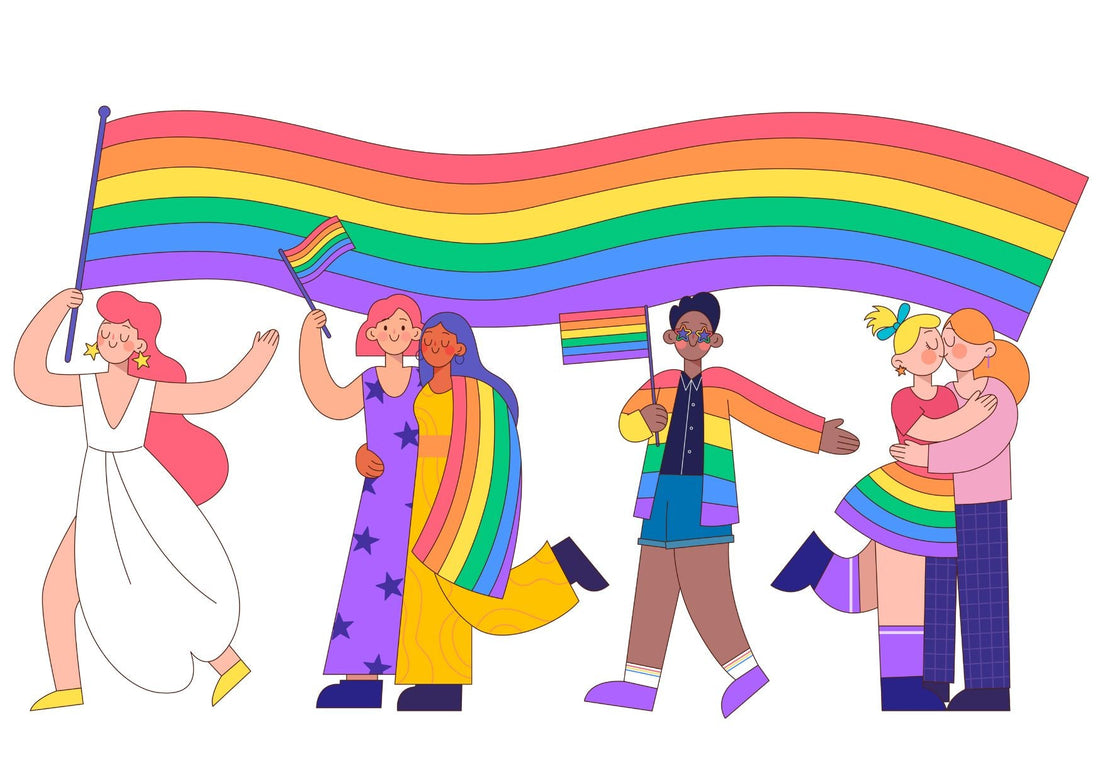
How did the flags of different LGBTQ+ identities come about?
Share
We see them at pride marches, on our friends' social networks, in store windows... But where did they come from and what do they mean? Today we'll introduce some of them!

Rainbow flag
We've probably seen several versions: The first, with six horizontal stripes, was designed in 1978 by San Francisco-based artist Gilbert Baker, who created it at the request of then-Congressman Harvey Milk , who was also the first openly gay person to hold that position in California.

In 2017, a black and brown stripe was added to the flag, created by the LGBT Affairs Department in Philadelphia, USA. What was the reason? The purpose of the new version was to introduce a new flag that would also take into account the non-white LGBT+ population. This version was followed a year later by the American designer Daniel Quasar, who introduced a new one: It contains not only the original six stripes designed by Gilbert Baker, but also a wedge with a black, brown, blue and pink roof and a white triangle. The new colors represent trans* people and people living with HIV or AIDS.

However, in the same year, another rainbow flag was created, with a yellow triangle instead of a white one and a purple ring inside it, representing intersex people. This version was created by Valentino Vecchietti from the United Kingdom.
Transgender flag
The tricolor flag, which consists of three stripes (blue, pink, and white), is much younger than the rainbow one: It was created only in 1999. Its author, Monica Helms, an American transgender activist, included all trans identities in it: male, female, and those who do not fit into any category.
However, according to Helms, the flag's design was not very well thought out; she herself described it as "an intervention from above" .
Non-binary flag
As we probably already know, there is no single non-binary identity : non-binary people can be gender neutral, have multiple genders at once, or none at all, or be at the intersection of them... And these are exactly the identities represented by the non-binary flag by Kye Rowan*a from 2014 – when he*was seventeen years old.

The flag consists of four horizontal stripes: yellow, which represents people who are neither cis men nor cis women, white, which represents people of many genders, purple, which represents people at the intersection of genders, and finally black, which belongs to people without any gender.
Intersex flag
This flag differs from many others representing LGBT+ identities in that it is not made up of stripes, but rather a purple ring on a yellow field. It was created by bioethicist and intersex activist Morgan Carpenter from Australia, who introduced it to the world in 2013.

And why was this geometric shape chosen? The symbol represents the wholeness of intersex people: intersex identity does not make anyone a broken or bad individual.
Flag of people on the asexual spectrum
We are deliberately writing about the flag of people on the asexual spectrum, because that is exactly what this black-gray-white-purple flag represents. Black represents asexual orientation, gray represents orientation between asexuality and allosexual orientations, white represents sexuality itself, and purple represents communities.

This flag came from a competition on the English-language AVEN (Asexual Visibility and Education Network) website in 2010, with the winner being an account named standup. AVEN then used the same colors for its logo.
Given that there are several asexual and aromantic, or borderline, identities, there are a number of flags similar to this one that refer to these gender identities or sexual orientations.
Bisexual flag
The bisexual pride flag is one of the relatively older ones, having been created in 1998. Its author is Michael Page, who lives in Florida and also created the now-defunct discussion forum BiCafe.com. The flag first appeared on this site.

It is made up of three stripes of unequal size: one wide, blue, which represents heterosexuality, the second wide, red, representing homosexuality, and the last, which is much thinner than the previous ones, is purple and represents their combination.
